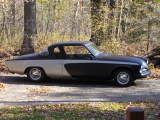I have seen variations of this question when searching the forums but here's a different angle. When you guys are installing new floor pans, do you weld them solid or just tack weld every 1/2 inch or so then seal up with seam sealer?
Announcement
Collapse
No announcement yet.
Welding solid vs. tack welding
Collapse
X
-
I'm no welding expert, but it seems like you would tack weld them to make sure the metal is lined up correctly and to hold it in place then run a solid bead of weld. Seam sealer after it's all done seems correct as well. If I'm wrong, I hope someone corrects me so I'll know as well.
Poet...Mystic...Soldier of Fortune. As always...self-absorbed, adversarial, cocky and in general a malcontent.Poet...Mystic...Soldier of Fortune. As always...self-absorbed, adversarial, cocky and in general a malcontent.
-
I agree, weld solid.
I used a butt joint and spot welded the pans to ensure proper fit. Then, welded them solid and seam sealed. My thinking was that welding them solid would add strength to the floors and help to keep things dry.
I did not use a lap joint, for fear that it would be a perfect place to trap moisture.
Scott
Comment
-
first you tack weld the piece in place once you have it where you want it then go ahead and weld it. but go in short welds so as not to warp the metal it takes a little time but always do it right the first time.mig welder is real good but try it out on scrap metal before you go to your project.
2006,f-150,2x4,v-6,5-speed manual,8ft bed, will post stude info when i get it on the road.
Comment
-
I put new floors in my '56 (passenger side only--front and back) and did pretty much the same thing. Tack weld in place and then run a bead all the way around--I did about 2" at a time and flip-flopped from side to side. I really took my time so as not to warp the floors. Then I ran seam sealer top and bottom. It should last forever.
Comment
-
When I realized that I was going to get into a full blown frame off restoration on my business coupe, I had just begun my sales job with a company that specialized in air tools, spray equipment, pumps, and complete industrial finishing systems that included simple open faced spray booths to conveyorized finishing lines. At that time, the company mostly supplied systems to the vast furniture industry in the southeast. With the things I learned from working on the car and interacting with my customers, it was a win win experience. If you really disassemble a car, you will note that there are butt weld seams, overlaps, and bolted together parts. There are situations where all are required and acceptable. On the occasions that I visited our headquarters where the Spray Booth shop was located, I would load up with all the scrap pieces of sheet metal they would give me. Since it was galvanized metal, I had to take precautions to protect myself when welding the stuff. I was too cheap to order replacement floor pans and fabricated my own. I used a combination of "Tech screws"(self drilling), pop rivets, and welding. My motto...what ever works!...If you will look at non-cosmetic areas of a car body...say...where two panels were joined in the rear wheel well areas, you will see that they were lapped, hammered and welded together. Where the seam goes to a cosmetic area above the fender...it was "leaded" to hide the seam. Just because it was considered an assembly line didn't mean that no skill was required.
The restoration process allows you to do two things better than the factory...seal up potential rust areas and add insulation and sound deadening qualities not available nor economically feasible at the time of original assembly.


John Clary
Greer, SC

Life... is what happens as you are making plans.
SDC member since 1975John Clary
Greer, SC
SDC member since 1975
Comment

Comment